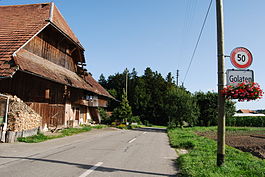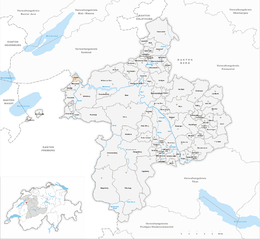Golaten
| Golaten | ||
|---|---|---|
 |
||
|
||
| Coordinates: 46°59′N 7°14′E / 46.983°N 7.233°ECoordinates: 46°59′N 7°14′E / 46.983°N 7.233°E | ||
| Country | Switzerland | |
| Canton | Bern | |
| District | Bern-Mittelland | |
| Government | ||
| • Mayor | Beatrice Johner | |
| Area | ||
| • Total | 2.8 km2 (1.1 sq mi) | |
| Elevation | 519 m (1,703 ft) | |
| Population (Dec 2015) | ||
| • Total | 314 | |
| • Density | 110/km2 (290/sq mi) | |
| Postal code | 3207 | |
| SFOS number | 0664 | |
| Surrounded by | Radelfingen, Mühleberg, Wileroltigen, Kerzers, Niederried bei Kallnach | |
| Website |
http://www.golaten.ch SFSO statistics |
|
Golaten is a municipality in the Bern-Mittelland administrative district in the canton of Bern in Switzerland.
Golaten is first mentioned in 983-93 as Gulada. In 1277 it was mentioned as Golatun.
The oldest trace of a settlement in the area are Roman era bricks and pottery fragments which were found near the Wittenberg farm. By the 10th century St. Maurice's Abbey was the largest landholder in the village. It eventually became part of the Herrschaft of Oltigen. The entire Herrschaft was absorbed by Bern in 1410/12, including Golaten. The village was always part of the parish of Kerzers. During the Protestant Reformation both municipalities converted to the new faith and Golaten remained part of the Kerzers parish. In 1793, it fought with the neighboring communities, in the Canton of Fribourg, over the Golatenmoos moor. The Golatenmoos is now part of the Bernese municipality of Kallnach. After the 1798 French invasion, Golaten remained part of the Canton of Bern, despite attempts by the Canton of Fribourg to annex it.
Today about half of the population of the municipality commute to jobs in Kerzers or Bern.
Golaten has an area of 2.8 km2 (1.08 sq mi). As of 2012, a total of 1.43 km2 (0.55 sq mi) or 51.1% is used for agricultural purposes, while 0.57 km2 (0.22 sq mi) or 20.4% is forested. Of the rest of the land, 0.23 km2 (0.089 sq mi) or 8.2% is settled (buildings or roads), 0.29 km2 (0.11 sq mi) or 10.4% is either rivers or lakes and 0.26 km2 (0.10 sq mi) or 9.3% is unproductive land.
...
Wikipedia




